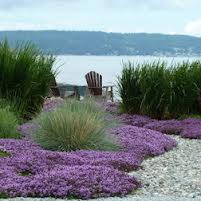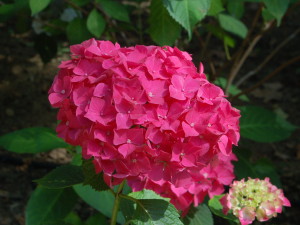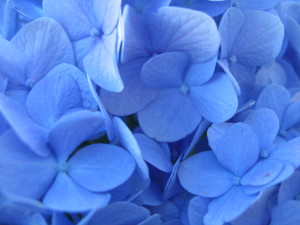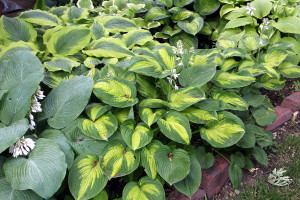 Gravitas: One of the Roman virtues, along with pietas, dignitas and virtus. It may be translated variously as weight, seriousness and dignity, also importance, and connotes a certain substance or depth of personality (Wikipedia).
Gravitas: One of the Roman virtues, along with pietas, dignitas and virtus. It may be translated variously as weight, seriousness and dignity, also importance, and connotes a certain substance or depth of personality (Wikipedia).
Spring is just down the street, bringing promises of new growth, rebirth, and fresh beginnings. I gaze out my window at the sodden lawn, looking at the jumble of weeds in what promises to be someday a pond. I avoid looking at the beds behind the arbor and instead focus on the swelling buds on my white lilac and the yellow hints on the forsythia bush.
Definitely my garden has depth and it feels like a serious place. But it lacks dignity and purpose. Oh, there are parts that start the feeling of weight: the paver patio, the winding gravel path, the raised beds. But the jumble in the distance looses focus.
Gardens need some structure to create a feeling of weight. Just like your living room, too much furniture or too many magazines create a feeling of clutter or even less importance. Reduce those magazines to three, open the spaces, coordinate the pillows and you are on your way to the front page of Better Homes and Gardens.
Your garden needs the same treatment. We let some bushes get too big, allowing them to spread and lord over others, spreading through suckers and seedlings. Other plants we keep even though they are half dead; we feel guilty pulling them up because Aunt Martha gave them to us. Or maybe the next door neighbor, who said, “Don’t worry. No one can kill this plant.” Admit it, you killed the plant. Or maybe something else killed it. Maybe it misses Aunt Martha. Whatever, cut your losses, pull it out. Move it to the plant hospital part of your yard. Then you won’t feel so guilty.
Trim the bushes. Make some space. Add a plant with red blossoms such as Rhododendron Grace Seabrook or Taurus. Add a bench, a winding path, an artistic urn at edge of a clearing. Limb up a tree, create a view. Visualize. Create. Gardens with Gravitas awaits each and every one of you!
 Happy New Year! January in the garden: what else could be wetter or colder? I suppose the Pacific Ocean or Hoodoo Ski area. We are blessed with relatively mild winter weather; it’s a great time to rake up storm debris, prune deciduous shrubs and trees, or even plant some new ones. Some great plants to add for winter interest are red twig dogwood, with fiery red stems in winter, or Arnold Promise witch hazel, with wonderful spidery yellow flowers that last for weeks. Want some fragrance? Try Daphne boliana, a winter blooming daphne with a wonderful citrus floral scent in the midst of winter. When you do winter raking and cleanup, you can leave some fallen leaves and needles around the base of shrubs and perennials to provide for winter protection from cold weather. Leave the mulch on till the weather warms; be sure to watch for slugs though and bait as needed. Lawns do not like leaves so feel free to rake away. If you notice flocks of birds feeding on your lawn, you may have crane fly larvae in your sod. These insects feed on the roots of your lawn and are especially prevalent in wet areas of your lawn. Treat crane fly with an appropriate insecticide now before Spring.
Happy New Year! January in the garden: what else could be wetter or colder? I suppose the Pacific Ocean or Hoodoo Ski area. We are blessed with relatively mild winter weather; it’s a great time to rake up storm debris, prune deciduous shrubs and trees, or even plant some new ones. Some great plants to add for winter interest are red twig dogwood, with fiery red stems in winter, or Arnold Promise witch hazel, with wonderful spidery yellow flowers that last for weeks. Want some fragrance? Try Daphne boliana, a winter blooming daphne with a wonderful citrus floral scent in the midst of winter. When you do winter raking and cleanup, you can leave some fallen leaves and needles around the base of shrubs and perennials to provide for winter protection from cold weather. Leave the mulch on till the weather warms; be sure to watch for slugs though and bait as needed. Lawns do not like leaves so feel free to rake away. If you notice flocks of birds feeding on your lawn, you may have crane fly larvae in your sod. These insects feed on the roots of your lawn and are especially prevalent in wet areas of your lawn. Treat crane fly with an appropriate insecticide now before Spring.
Enjoy the winter sun mixed with the rain; we are busy at the nursery cleaning, ordering new stock, and gearing up for garden planting time! Come by and check out the sale in the gift shop; many items are being closed out and liquidated for great savings. Or just stop by to say “Hi!”; we love a chance to visit and share garden lore. See you soon!
You may have heard that you can change the color of a hydrangea’s flowers by adjusting soil pH. But there’s a little more to it than that. First of all, not all hydrangeas produce blue flowers. Hydrangeas with white or cream flowers, such as Annabelle hydrangeas, oakleaf hydrangeas and members of the PeeGee family, can only produce white or cream flowers. Sometimes their blooms take on a pink tinge at the end of the season, but that’s about as colorful as they get.
Hydrangeas with bloom colors that range from pink through blue and purple usually belong to the hydrangea cultivars known as mopheads and lacecaps. These types of hydrangeas have the interesting ability to change the color of their blooms based on the chemistry of the soil. When grown in alkaline soil, the bloom colors are pinker. When grown in acidic soil, the bloom colors are bluer.

 Because soil chemistry determines the bloom color, the variety names given to these types of hydrangeas means very little when it comes to bloom color. For instance, Nikko Blue, Pretty in Pink, Forever Pink and Blue Deckle, all have an almost equal chance of blooming pink or blue, depending on the soil they are planted in. So remember that even if you purchase a hydrangea in bloom, you cannot be sure the plant will produce the same color flowers once it’s growing in your garden.
Because soil chemistry determines the bloom color, the variety names given to these types of hydrangeas means very little when it comes to bloom color. For instance, Nikko Blue, Pretty in Pink, Forever Pink and Blue Deckle, all have an almost equal chance of blooming pink or blue, depending on the soil they are planted in. So remember that even if you purchase a hydrangea in bloom, you cannot be sure the plant will produce the same color flowers once it’s growing in your garden.
To manipulate the color of a hydrangea’s blooms, the soil’s pH level and mineral content need to be changed. In order to maintain growing conditions that result in a specific bloom color, you may need to apply specific soil amendments several times during the growing season To encourage blue hydrangea flowers, grow the plant in soil that has a pH of 5.2-5.5. If your soil is more alkaline, you can lower the pH by applying garden sulphur at the rate specified on the package. Soil pH can also be lowered (more gradually) by applying an acidic organic mulch, such as pine needles or fir bark.
Our soils tend to be acidic. Many gardeners also use iron to intensify the blue colors of their hydrangeas. If the pH of your soil is naturally quite high (alkaline) it will be very difficult to get blue flowers — even if there’s plenty of aluminum in the soil. Alkaline soil tends to “lock up” the aluminum, making it unavailable to the plant. (However, you can grow fabulous pink hydrangeas!)
If you prefer pink blooms, your hydrangea should be deprived of aluminum by growing it in an alkaline soil with a pH of 6.0-6.2. You can apply a high phosphorus fertilizer to further discourage the uptake of aluminum. To raise the pH of a naturally acidic soil, apply garden lime at the rate specified on the package.
Giant thistle-like plants, artichokes and cardoons are beautiful as well as edible. Their prickly-silver leaves make an excellent backdrop in any garden. Artichokes and cardoons are fun and relatively easy to grow in our coastal gardens. By mulching and cutting them back in the fall, they can survive our occasional cold winters. I like to grow them even as an annual; their dramatic bold outline in the flower bed is a wonderful addition.
Green Globe and Imperial Star are two of the most common artichoke varieties.
Plant artichoke starts in deep, well-amended soil in full sun. Space them three to five feet apart. Since they can grow three feet or more in height, think about the shade they will cast when planning your garden. Mulch and water regularly.
By mid-summer, your artichoke plant should send up flower buds, which should be harvested before they open if you want to eat them. If you let them flower, they will produce a huge purple thistle that can be dried and used in arrangements. If you harvest all the flowering heads, artichokes often send up a second crop of flowers in the fall in milder climates.
An artichoke will produce well for about three or four years. After that time, it is best to dig and divide it, as it produces off shoot plants that may crowd the original plant. In the fall, cut back your artichoke plant and mulch it with a covering of leaves or straw. After mild winters, new plants will sprout from the old parent plant in the spring. Uncover them in April. Cold winters, such as this past winter in western Oregon, may kill artichokes, whether or not they are mulched. Cardoons are a close relative of the artichoke, grown for their thick fleshy leaf bases.
Harvest, peel, steam and enjoy!
 From spring to frost the many looks of Hosta foliage and flowers decorate gardens with lush, colorful texture and structure. They are both architecture and sculpture. They make wonderful fillers and the small leaf varieties make wonderful low edging plants. How about using them in containers – absolutely!
From spring to frost the many looks of Hosta foliage and flowers decorate gardens with lush, colorful texture and structure. They are both architecture and sculpture. They make wonderful fillers and the small leaf varieties make wonderful low edging plants. How about using them in containers – absolutely!
Right now at the nursery we have some stunning Hostas:
- “Blue Angel” has large textured blue leaves with a white flower in July. This is large Hosta that can be 3 ft x 4 ft. “Captain Kirk” has bright yellow leaves with a green edge. This plant can take part sun and sends up lavender flowers on a 3 ft stalk. Beaming!
- “Olive Bailey Langdon” has a heavily textured blue green leaf with broad gold edges. Grows 24 inches high with near white blooms.
- “Pineapple Upside Down Cake” a scrumptious plant with interestingly shaped rippled leaves that start out green then take on a bright gold center in mid-summer.
- “Sum and Substance” is a wonderful large grower with 18 inch long leaves of chartreuse that warm to gold as the season progresses. And substance? Well this plant can reach 4-5 ft wide and 2 1/2 ft tall. Imagine that with lavender flowers on 50 inch scapes in August.
Best in moist, rich, well drained soil (just add some of our Royal Soil to your sand) in shade to part shade. Hostas rarely disappoint with their dramatic foliage, vigorous growth, and easy care.
From Renee’s Garden Recipes
This moist cake is not too sweet and has enticing highlights of chocolate and orange. A welcome change from ordinary zucchini bread or carrot cake.
2 cups sifted unbleached all-purpose flour
1 teaspoon baking powder
1 teaspoon baking soda
1/2 teaspoon salt
1/2 teaspoon cinnamon
1/3 cup unsweetened cocoa
1 3/4 cups sugar
1/2 cup vegetable oil
2 teaspoons freshly grated orange zest
1 whole egg, slightly beaten
3 egg whites, slightly beaten
2 cups finely shredded, unpeeled zucchini
1/3 cup buttermilk
1 teaspoon vanilla
1/2 cup chocolate chips
GARNISH: Sifted powdered sugar
Preheat oven to 350˚F. Lightly grease and flour a round 10-inch springform baking pan.
Sift together the flour, baking powder, baking soda, salt, cinnamon, and cocoa two times. In a large separate bowl, combine the sugar, oil, and orange zest, mixing well. Add the whole egg and egg whites, one at a time, mixing well after each addition. Stir in the zucchini. Combine the buttermilk and vanilla in a separate cup.
Add the dry ingredients to the zucchini mixture alternating with the buttermilk and vanilla, a third at a time, mixing well after each addition. Stir in the chocolate chips until just combined. Pour into prepared pan and bake 30 to 35 minutes, or until a wooden pick inserted in center comes out clean.
Let the cake cool on a wire rack for about 20 minutes, then run a knife around the edge of the springform pan, between the pan and the cake. Remove the sides of the pan. When the cake is completely cool, sprinkle with confectioners’ sugar. Serves 8 to 10
August is an ideal time to plant seeds for a second gardening season that can be as productive as your major early spring plantings.
For a delicious and very nutritious cornucopia of fall meals, late summer is the time to plant lettuces, some herbs (dill, garlic, chives, arugula, parsley), healthy leafy greens (chard, kale, pak choi), and healthy root veggies (carrots, beets, leeks, radishes, fennel), and brassicas (broccoli, cauliflower, cabbage, brussel sprouts).
Late planted crops have less competition from weeds and pests and grow beautifully with less garden work. In mild-winter areas of the country, you’ll have great harvests in time for Thanksgiving and many crops will hold perfectly through the low light winter months without bolting to seed or becoming bitter tasting as they would in the heat of early summer.
It may seem odd to be starting new seeds when a lot of your summer produce such as squash and tomatoes are still cranking, but it is well worth the effort. For reliable harvests in cooler weather, seedlings must have good initial growth and well-established root systems. The goal is to have fully grown, ready-to-pick plants that basically store themselves in the garden throughout the fall, so you can pick them as you need them over a long sustained harvest season.
Start seeds in containers or in a garden area with dappled sun or light shade — wherever seeds can germinate comfortably out of the hot sun but still get plenty of light after seedlings are well-established. Plant seedlings in well-prepared moist soil in the early morning or evening so they will have the advantage of cooler night temperatures to settle in and minimize shock.
Once the seedlings have acclimated, don’t forget to supply adequate moisture to these young crops and fertilize them regularly in the early growing stages. In USDA zones 8, 9, and 10, some fall -planted crops may overwinter as small plants and wait for spring temperatures to rise and daytime hours to get longer before heading or leafing up.
 Chusquea culeou is a South American native that grows in the lower elevations of the Andes Mountains, primarily in southern Chile. It can grow to a mature height of about 15′, with a spread of about 5′ within 4 – 5 years. This bamboo has a columnar to vase-shape form as a mature plant. The short branches are nearly whorled around the culm lending a tufted or plume-like appearance to the foliage (thus the common name Chilean Feather Bamboo).
Chusquea culeou is a South American native that grows in the lower elevations of the Andes Mountains, primarily in southern Chile. It can grow to a mature height of about 15′, with a spread of about 5′ within 4 – 5 years. This bamboo has a columnar to vase-shape form as a mature plant. The short branches are nearly whorled around the culm lending a tufted or plume-like appearance to the foliage (thus the common name Chilean Feather Bamboo).
This bamboo can also offer some spectacular seasonal color. In early spring, the culms can turn a range of colors ranging from magenta to chocolate-burgundy. Color is most dramatic when the plant is sited in full sun. Like most all temperate clumpers, this bamboo requires cool summer nights to survive and thrive, so the lowland climate of Western Oregon is ideal for growing this bamboo. For the most vigorous growth, plant it in full sun, in rich moist soil, and give it plenty of room to grow. Chilean Feather Bamboo is a clumping bamboo, but gets taller and spreads more quickly than most other clumping bamboos. For the best performance and least maintenance, you should set aside an area of garden space at least 6′ in diameter.
I’m watching Olympic cycling this morning, laptop clicking away with quick glances at the big screen trying to get a glimpse of Box hill Road. If you didn’t know, this month is talk like a Brit month at the garden center. We will be calling basil (known as “bay zell”) “bah zill”, cotoneaster (known as “ko-tony-aster”) “cotton-easter”, and our friends “blokes”. When watering we will be referring to our irrigation system as our “lovely gubbins”, and our daily work will be “easy peasy”. While you’re at the nursery, be sure to check our horse chestnut tree where we will be fervently watching it grow so we can get some horse chestnuts this fall and play a game of “conkers”. Maybe I can play conkers in my yard with the spruce cones that will be dropping soon.
The English are to me the ancestors of garden lore. What is an English Garden like and how does it differ from an American Garden? The English Garden is more of an “Outdoor room” an extension of the house that should be just as attractive and comfortable as a room in the house. We call the front of our house the “yard”, whereas the Brits call it the “garden”. It is seen less as somewhere to “produce” things – food, flowers for cutting, but more as an outdoor living space.
In designing an English garden, create your framework through the use of hedges and borders. Taller hedges include holly, escallonia, or even clipped cedar trees. Softer hedge lines can be created using hydrangeas or even grasses such as Miscanthus “Adagio”. Perennial flowers are a major part of the inner color of an English garden. In our area, try Rudbekia, Shasta daisy, Crocosmia “Lucifer”, or Lobelia “Cardinalis”. Unknown but worthy perennials for taller lest windy areas of your garden can include Rodgersia and perennial Phlox. Be sure to include herbs and vegetables in a sunny well drained corner; try Rosemary “Arp” or Lavender “Silver Edge” for larger herbs, creepy Elfin Thyme for your pathways. Colorful Swiss Chard “Neon Lights” is a great edible border addition.
No EnglishGarden is complete unless it includes a rose. Disappointed with hybrids teas? Try a hardy shrub rose such as the Knockout roses or the very hardy Rugosa rose.
Be sure to include a small patio; it can be of pavers or even small gravel. Upon it you need to put your lounge chair and small table. At 4:00 we will over to enjoy a spot of tea!
Make sure your landscape receives enough water to avoid drought stress. Our weather goes from plants getting water and moisture every day to no rain for months. Even established plants, especially rhododendrons and flowering spring shrubs can use an occasional watering in the summer. For a green lawn, make sure lawn areas are receiving adequate water (approximately 0.5 to 1.5 inches per week from June through August). You can measure your water use by placing an empty tuna can where your irrigation water lands. With our sandy soils, frequent watering with less time is more cost effective than deep watering as the soils do not retain moisture. If you have an irrigation system, make sure you check your timer to ensure that the run times and start times are correct and that the proper amount of water is being put down in your landscape. For additional technical advice, stop in at the nursery or schedule an appointment with our irrigation technicians.
